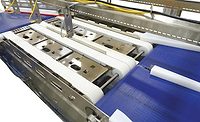Customized Solutions
By SARAH THEODORE
The options for functional beverages get more
sophisticated and continue to grow
The generic term “nutraceutical” leads the list of
functional claims for beverages introduced this year, according to
Datamonitor’s Productscan Online. But today’s products are
anything but generic, and beverage-makers have a number of ingredients from
which to create everything from mass market juice drinks to
condition-specific formulations.
Product claims such as high calcium, protein and
vitamins are down this year compared to last, according to Productscan,
while antioxidants and minerals are outpacing 2005. Green tea is the
headlining ingredient in antioxidant beverages by far, in various forms
such as “green tea,” “green tea catechins,”
“green tea extract,” “instant green tea” and
“green tea leaf extract.”
|
||||||||||||||||||||||||||||||||||||||||||
Vitamin C is another leading antioxidant source this
year, and free-radical-fighting acai, acerola, bilberry, black currant,
black tea, blueberries, noni, pomegranate, vitamin E and white tea also
have made a showing in new product introductions.
Overall, the functional food and beverage market is
worth more than $20 billion in the United States and $55 billion worldwide,
reports Mark Fanion, spokesman for Fortitech Inc., Schenectady, N.Y., a
producer of nutrient premixes. He says that the increased awareness of the
impact between nutritional content and overall health has fueled
double-digit growth in that market.
“Today’s consumers are concerned with
overall health and wellness,” he says. “As a result, there is
significant impact on food and beverage purchases. Many studies have shown
that consumers are as concerned with good health as they are about
maintaining a high quality of life.”
Demand for organic and natural ingredients is growing,
Fanion says. And it should come as no surprise that energy-boosting
ingredients also are on the rise. Today’s most sought-after beverage
ingredients include taurine, caffeine, antioxidants and lycopene, as well
as soy, DHA/EPA, mixed tocopherols, phytonutrients and sterols, he says.
“The trend is reflective of consumers’
desire to maintain and improve energy, reinvigorate and replenish body
fluids, manage weight gain and enhance the nutritional value of popular
beverages,” he says.
Dan Murray, vice president of sales for food and
beverages at InterHealth Nutraceuticals, Benicia, Calif., says the
popularity of energy drinks has expanded the mass market possibilities for
many ingredients once reserved for nutritional products only. InterHealth
produces a number of nutraceutical ingredients, including Super CitriMax,
ChromeMate and OptiBerry.
“The energy market has opened the door to what
can transfer from nutraceutical to mainstream beverages,” he says.
“There are many applications for other nutraceuticals that have, so
far, been taken in capsules and tablets.”
Consumers often prefer to ingest functional
ingredients through beverages rather than supplements because of their ease
of consumption and their portability, he says. “We’re all going
to consume something and if we have the option of consuming something that
has a health attribute, that’s a bonus,” he says.
Some of the challenges in developing fortified
products are that the ingredients can be difficult to incorporate into a
beverage, and can cause undesirable flavors, sedimentation or unintended
ingredient interaction.
“Certain nutrients are not very soluble, so one
has to select the correct form to avoid sedimentation,” Fanion says.
“Certain nutrients may give a bitter aftertaste and some are not very
stable. Others may be light and/or heat sensitive.” Fortitech offers
custom premixes of vitamins, minerals, herbs and many other nutrients that
can be used to design products for specific health conditions and avoid
formulation problems.
Belief vs. behavior
Another hurdle in developing and marketing functional
beverages is that consumers’ intentions don’t necessarily match
up with their actions. According to Datamonitor’s How to Exploit New Wellness Trends in Drinks report, 45 percent of consumers say they “find it
difficult to maintain a lifestyle focused on health and wellness in the
long term.”
The development of healthful, yet convenient products
is essential to capturing these consumers who would like to make healthy
choices but cannot sacrifice the time to do it.
More difficult to overcome is that a number of
consumers indicate that they are skeptical of health claims on products.
Nearly 45 percent of consumers in the United States doubt the
trustworthiness of health claims by food and beverage-makers, Datamonitor
reports.
The good news for beverage
formulators is that U.S. consumers are more confident than their
counterparts in the rest of the world, including the United Kingdom, where
nearly 65 percent of consumers say they are distrustful of product claims.
Datamonitor suggests beverage companies can overcome
consumers’ doubts by forgoing scientific claims that consumers cannot
easily understand. Promoting products that are more “natural”
also can go a long way toward easing concerns, as is indicated by the
recent growth in the natural and organic segment.
Areas of growth for fortified or wellness beverages,
according to the report, include diet and weight management drinks;
cosmeceutical products; products perceived as “fresh”; and
products customized toward specific demographic targets.
Also poised for growth, according to Fortitech’s
Fanion, are fortified beverages containing fiber, protein, soy isoflavones,
co-enzyme Q10, plant extracts and probiotics.
“In order to be successful in the marketplace,
one has to think in terms of health innovation, flavor innovation,
ingredient innovation and specific age groups,” Fanion says.
“These are the factors that will shape the future of the beverage
industry.”
Up and coming categories
The category of diet drinks has expanded in recent
years to include products that not only contain fewer calories, but those
that actually help consumers lose or manage their weight. InterHealth
Nutraceuticals produces Super CitriMax and ChromeMate, both of which are
designed to help consumers manage their metabolism.
“We’ve gone the gamut in weight management
and weight loss from low-carb to portion-control products,” Murray
says. “We’re getting now into metabolic ways you can adjust
appetite. That’s very exciting because it takes away the restrictions
of diet and it takes away the hunger
pangs.”
The company’s Super CitriMax is hydroxycitric
acid that is extracted from fruit rinds and is used to create a feeling of
satiety. Murray says it also interrupts carbohydrate metabolism and the
conversion of carbohydrates to fat. ChromeMate is niacin-bound chromium
that aids in insulin modulation. Both ingredients can be found in Fuze
Beverage’s Slenderize product as well as SoBe Lean, and Super
CitriMax is the featured ingredient in Jana Skinny Water.
Elite FX, Boynton Beach, Fla., last year introduced
Celsius, a beverage that uses a “thermogenic blend of nutrients,
caffeine and botanicals,” which consist of taurine, guarana, green
tea extract with 10 percent EGCG, caffeine, glucuronolactone and ginger
root extract to create a metabolism boost.
The antioxidant power of fruit has made sales
superstars out of products such as Pom Wonderful and Sambazon Acai. Another
berry becoming popular for its antioxidant content is goji, a Himalayan
fruit containing high levels of vitamin C, beta carotene, iron and amino
acids.
Recently, CherryPharm Inc., Geneva, N.Y., rolled out
CherryPharm, an all-natural, not-from-concentrate cherry juice, promoting
the product as a natural recovery juice, and calling cherries natural pain
relievers, anti-inflammatories and sleep regulators.
The role of fiber in a healthy diet is taking on more
importance, and National Starch Food Innovation, Bridgewater, N.J., has
added Nutriose, a dextrin-based fiber that can be incorporated into
beverages.
“Just about every one of us understands how
difficult it can be to consume the recommended amount of fiber day after
day and still maintain a diet considered appealing and enjoyable,”
says Deborah Dihel, business development manager, soluble fiber, at
National Starch.
Nutriose can provide up to 5 grams of soluble fiber
per serving in a beverage, and can be used in products such as juice,
flavored waters and dairy-based drinks without affecting clarity, taste or
mouthfeel. In fact, the company has found it often can improve the
mouthfeel of a product.
“The concept of fiber fortification is still
relatively new in the beverage industry, providing innovative companies
with the option to consider fiber as a differentiator,” Dihel says.
“Marketers of beverages are coming to realize that fiber added to
beverages will one day be the most consumer-appealing way to deliver all
the benefits fiber has to offer.”
From the inside out
Another potential area for new products is
beauty-enhancing beverages such as Borba Skin Balancing Waters and
Aqua-less Crystalline Powder Packets. The products, from Borba LLC,
Woodland Hills, Calif., contain vitamins and ingredients such as a gelatin
complex designed to enhance the skin’s appearance.
In a unique retail positioning, Borba made its debut
in Sephora and Nordstrom stores, targeting the cosmetic section over the
beverage aisle. It has since moved into upscale
grocery accounts in East Coast, Midwest and West Coast markets.
Datamonitor reports the market for oral beauty
supplements in the United States has increased from $299 million in 2000 to
$742 million in 2005, and is expected to grow to $1.2 billion by 2010 as
consumers look to nutrition to help them look better. It cites 69 percent
of respondents in an Olay Vitamins survey who indicated that they believe
vitamins and supplements help maintain healthy-looking skin, as well as the
growing number and greater disposable income of aging females as indicators
of this product opportunity.
But just as they are skeptical about overall
nutritional product claims, Datamonitor says consumers have trust issues
with functional beauty claims. It suggests promoting such products as part
of everyday skin nutrition and focusing on
“healthy” categories. “Consumers may not believe food and drinks are good for them if they contain
many processed ‘bad’ ingredients, so focus on categories
considered generally healthy,” the company says in its Seeking Beauty through Nutrition report. “Studies have found that fatty and processed
foods are associated with poor skin health, unlike wholesome foods and
fruit and vegetables.”
Just for me
InterHealth’s Murray believes future
fortification opportunities exist in products that can be customized to
consumers’ specific needs. “Some of the more exciting things
are things like Jamba Juice, where people are going in and adding
functional ingredients, right on the spot,” he says. “Somebody
can customize what would normally be an existing product to their
preference.”
In packaged beverages, this could include the recent
popularity of single-serve packets of powdered drinks. “You can carry
it in your car, your purse or pocket, and it gives you the option to add
functionality,” he says.
Murray is not alone in believing customization is a
key for future fortified drinks. In a recent ACNielsen report titled The Future of Health and Wellness, the company teamed up with the Hartman Group, Belleview, Wash.,
to determine consumer purchasing drivers, including customized food and
beverage solutions. Laurie Demeritt, president of the Hartman Group
commented, “The power of customization is that each customer feels
that they have special requirements. Consumers are looking for
manufacturers who recognize ... that they are ‘special’ and
have diverse needs.”

